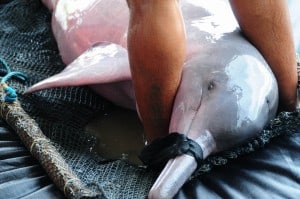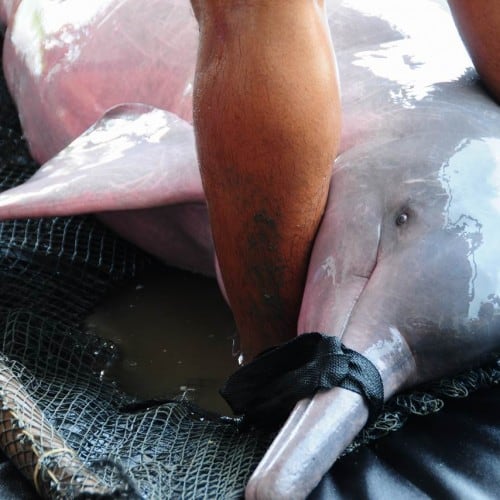 Truth is they started off as Pacific ocean dolphins, then the Andes got thrust up blocking their route home. So they had to adapt – which they did to freshwater permanently – and the pink is just some weird consequence of that. Anyway they’re a spectacle. And the origin of the pink? Well it’s more prominent on the older dolphins, particularly the males who are forever fighting. The pink exposes from scars of battle apparently. There are grey dolphins here too – while 25m years aprt from the pinks as a species, also a long way from their original homebase, the Atlantic ocean and they too have had to adapt to being in freshwater permanently. Not sure how they found themselves so far from their origins but anyway I’m told they do not return to the Atlantic ever. Bit of a long drive afterall – 2,000kms. See dolphin photos here
Truth is they started off as Pacific ocean dolphins, then the Andes got thrust up blocking their route home. So they had to adapt – which they did to freshwater permanently – and the pink is just some weird consequence of that. Anyway they’re a spectacle. And the origin of the pink? Well it’s more prominent on the older dolphins, particularly the males who are forever fighting. The pink exposes from scars of battle apparently. There are grey dolphins here too – while 25m years aprt from the pinks as a species, also a long way from their original homebase, the Atlantic ocean and they too have had to adapt to being in freshwater permanently. Not sure how they found themselves so far from their origins but anyway I’m told they do not return to the Atlantic ever. Bit of a long drive afterall – 2,000kms. See dolphin photos here
The Mamiraua Reserve is a good working example of the interface of environmental values with the values of indigenous inhabitants. It’s a real attempt to get a sustainable JV going. Is it working? The whole concept of an ecological development reserve – where biodiversity protection interfaces with lifting the local population out of poverty – seems at first an oxymoron, especially where that population’s livelihood is dependent on fishing and forestry – both exploitative activities that it seems are impossible to prevent tipping over into over-exploitation in most parts of the world. But so far this project, begun in the 1980’s by biologists working on foundations established by the Catholic church, and since funded by a number of bodies including the UK & Brazilian governments seems to be hanging together. The population within the Reserve isn’t huge – 6000 – and they tend to live in about 20 small communities (two of which are pure indigenous people) of about 13 families each, perched on the riverbanks. See photos of community here
The interdependence of the forest and the fish and aquatic mammalian life as the latter depend on the forest for food while the latter depend on the fauna to spread the seeds. Historically the biggest problem has been the intrusion of commercial interests into the area from other parts of Brazil that have brought modern harvesting techniques, had no regard for the livelihoods of the locals and been intent on exploiting the hunting, fishing and forestry to extinction. That has led to violent conflict and with mixed success, the eventual exclusion of these outside interests and the instigation of sustainable management of the resource for locals. The most serious freshwater fish is the Pirarucu, that can reach over 3 metres in length, has to come to the surface every 20 minutes for oxygen and is in abundance around our floating lodge. They remind me very much of ling in that they are pink coloured with similar eel-like tails.
Is the programme lifting the income of the locals? The general view is that it is, that the work at the ecotourist lodge in particular is a source of cash (cooks, housekeepers, guides, building maintenance) . Insofar as the ecological management and research work is concerned there is some spinoff as well, with locals being involved in the monitoring and management programmes. All in all the Mamiraua project is regarded as the leading example of ecological and development management in Brazil, certainly in the Amazon.
It’s incongruous that the pink dolphin would, during the wet season be swimming amidst the trees of the forest – that must be one of the weirdest sights to behold in this flooded forest of the Amazon.


Comments are closed.